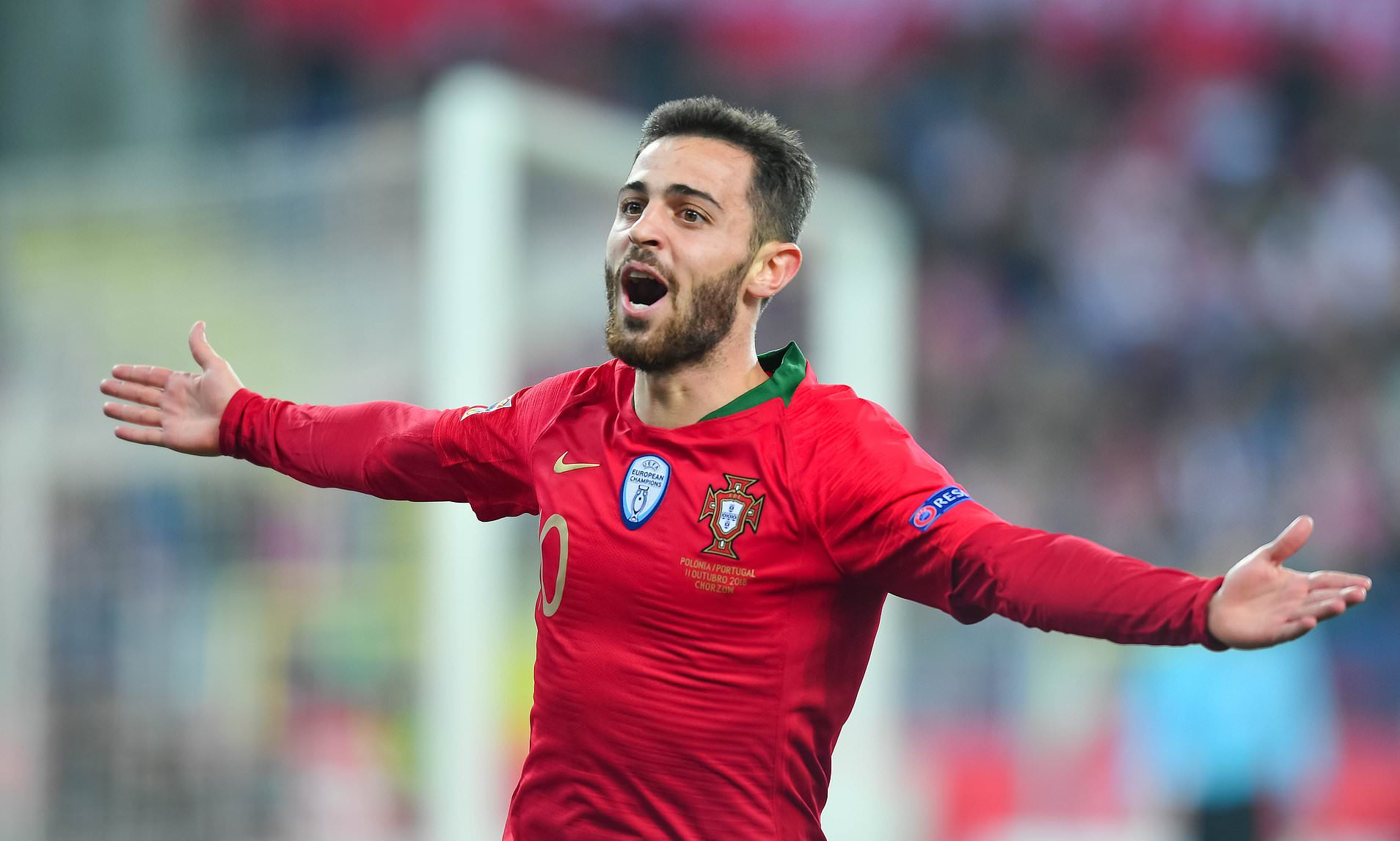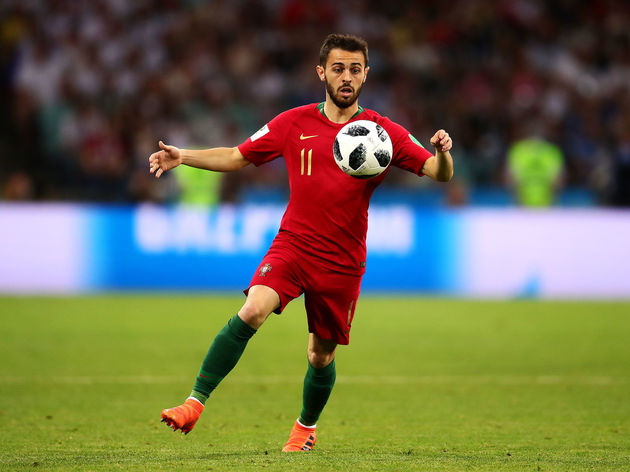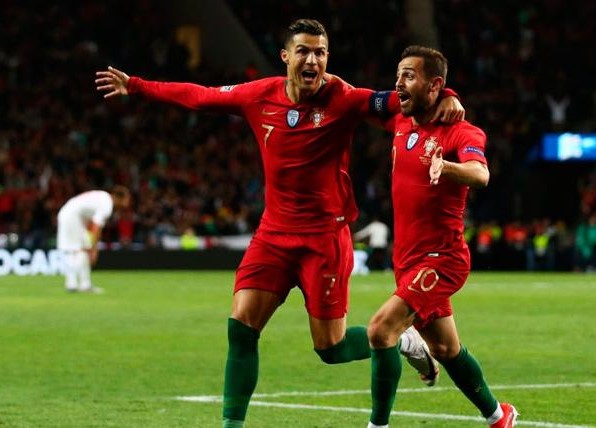 How Silva can reincarnate the mythical No.10 role for Portugal
How Silva can reincarnate the mythical No.10 role for Portugal
Bernardo Silva.
Following another exquisite display of football genius last week, tribute for the Seleção’s most exciting player in years has rained down from all corners of the Portuguese supporter community. A well-taken goal and three assists hardly told the full story of Portugal’s diminutive midfield soloist, who headlined in an unfettered, central-midfield-wanderer role against Lithuania and Luxembourg which proved devastatingly effective.
In keeping with this site’s 15-year tradition of producing the world’s finest English-language content on Portuguese football, PortuGOAL.net has elected to highlight one of the relevant queries of this era of the Seleção - how best to inspire this squad through the greatness of Bernardo Silva?
Join Nathan Motz as he embarks upon a tour through football history trying to find the elusive answer.
It has been two years since I first called for Bernardo Silva to be employed as a central playmaker. In that time, Fernando Santos has only ever allowed rare opportunities to behold this phenomenon.
Each time he does, the clamor to make the move permanent grows. Disbelief, too, abounds regarding how Santos fails to imagine what this team might become with Bernardo fielded centrally. The outcry for Bernardo to assume the mantle of that most famous of Portuguese maestros, Rui Costa, now almost seems a parody of itself. Bernardo excels as a No.10, somehow affirming our convictions, followed by a hasty return of the status quo with Bernardo on the right wing - ad infinitum.
What makes Bernardo Silva sparkle in the heart of Portugal's midfield? To behold it is like hearing the echo of a song from the past which ceased playing long ago, but somehow retains its captivating hold on our senses.
Positional traditions
I highly recommend a great book called “Inverting the Pyramid” which diagnoses the evolution of football tactics and player positions. In this history of the game, the prototypical roles are attached to a numerical system. The No.1 is a goalkeeper, No. 6 is a defensive midfielder of which there are at least two variants, No.9 is the striker, No.7 is a wide attacking midfielder or winger, and so on.
This numerical system is old enough that some may not know exactly what I mean by No.10. In this article, I use it to roughly define the position occupying that territory of central midfield in the space behind two strikers in some variant of a 4-4-2. Zinedine Zidane, the aforementioned Rui Costa, Deco, Juan Román Riquelme, and others have personified the creative essence of this position.
In this role, masterful use of the ball in close quarters, an ostensibly telepathic relationship with surrounding teammates, and unselfish distribution are prioritized over raw pace. Riquelme was so slow many defenders caught up with him after initially being beaten on the dribble only to be humbled a second time. In contrast, the archetypical winger – No.7 - combines physical strength and speed to provide width and dangerous crosses from the margins of the pitch.
Many No.10s were aloof playboy types and suffered from what might be described the “creative illness” – talent bordering on the absurd, but lethargic and undisciplined on the pitch while prone to capricious bouts of poor judgment off it. Ronaldinho has often been described in this way especially near the end of his time at Barcelona. The apathetic savant.
At the height of this era, the most talented player on the pitch became the funnel through which all creative energy poured. No.7s with pace to burn complemented the arrangement as willing recipients of a No.10’s artistic distribution, and possibly to trouble defenders who might otherwise gather around the more languid and contemplative type of player often found in this creative midfield role.
For decades, Portugal’s greatest players were often found on the wing. Paulo Futre, Luís Figo, Nani, and the great one himself, Cristiano Ronaldo, bear testimony to the Seleção’s rich heritage and wealth of natural talent at the No.7 position.
But the game of football has changed. With the rise of the barn-storming modern fullback, it has become a rarity for a winger to drive hard for the byline and deliver a teasing ball into the penalty area. Over time, wingers began to silently disappear in favor of hard-working, box-to-box midfielders, preferably those that still retained the artistic inspiration of old. Luka Modric and Toni Kroos are prime examples. N’Golo Kante’s work rate alone might be the hidden reason Leicester City shocked the world by winning the Premier League a few seasons ago. Versatility and industry are now the most desirable midfield virtues.
At present for the Seleção, there are no unbridled mustangs in the mold of a young Ronaldo or Quaresma. The only players in Portugal’s stable I would feel comfortable describing as an orthodox winger are Gonçalo Guedes, Rafa Silva, and Bruma. None of them are as essential to the squad as the wing-wizards in their lineage.
The conventional winger is an endangered species. Midfielders are no longer speed merchants and frequently meander inside while the fullback makes the overlapping run to provide width. Plenty modern midfielders are strategically positioned on the wing opposite their strong foot to facilitate the natural motion of carrying the ball centrally.
 Midfielders like Bernardo Silva.
Midfielders like Bernardo Silva.
The end of an era
At the same time fullbacks were subsuming the traditional winger, the No.10 fell victim to a significant tactical revolution: the dynamic press. Teams which lacked the individual talent to defend against the individual brilliance of the classic No.10 began to rehearse aggressive possession-recovery tactics. Jürgen Klopp has suggested “no playmaker in the world can be as good as a good counter-pressing situation.”
As the nature of the game prioritized strength and industry in midfield, the slothful No.10, unable to recover defensively or press the ball - think Cesc Fabregas – fell victim to football’s version of natural selection. It was only a matter of time before the game’s lethargic geniuses were swept away by the wave of high intensity, gegenpress tactics.
Barcelona’s pressing schemes also contributed to the disappearance of the lone playmaker. I believe much of the reason for their success rested not on their individual talent, which was considerable, and not even in their unparalleled ability to keep possession. It was their withering, relentless pursuit of the ball when not in possession that simultaneously made them invincible and expedited the decline of the solitary central midfield virtuoso – the No.10.
It took many years, but the football world began to understand that channeling a team’s creative energy through one player was tactically unsustainable. Barcelona had a revolving door of exquisite midfielders who more than simply directed traffic toward the opposition goal. They were tirelesss and exchanged positions with each other at will. Messi may have been an obvious focal point, but almost any midfielder on the squad could slot into a central position and play the killer throughball. As a result, they were at times unplayable.
Modernizing Portugal's central midfield
So fullbacks have replaced wingers, and versatile, lung-busting box-to-box midfielders have succeeded the No.10. What does any of this have to do with Bernardo Silva?
We are at the literal apex of Portuguese football. There has never been a more successful group of players in the history of the Seleção. Even so few would argue Fernando Santos’ Portugal lacks imagination. The sigh for lack of creativity has grown ever louder since Cristiano Ronaldo’s vacating of his quintessential wing role. Many say Portugal’s baffling inability to produce quality strikers and Ronaldo’s aging legs precipitated this change, but I believe it is just as much a symptom of the shifting landscape of the game itself.
For Portugal, it is interestingly William Carvalho who now carries the heaviest burden in midfield. Since Fernando Santos assumed charge of the Seleção, many midfielders have attempted to become the primary creative outlet. None have succeeded. Renato Sanches, Andre Gomes, Joao Mario, Adrien Silva, and others have all played their part in Portugal’s successes, but Portugal seem to be searching for something more. In the meantime, more has been asked of William making his injury absence that much more difficult for the Seleção.
In both of the last two matches, the formation was altered from a 4-3-3 to a 4-4-2 to allow Bernardo a platform to orchestrate Portugal’s most potent attacking movements. It also helped seal the gap in midfield left by William’s absence. Pizzi and Bruno Fernandes, modern No.8s, flanked him on either side and worked with Raphael Guerreiro and Ricardo Pereira on the margins of the pitch.
All well and fine against Lithuania and Luxembourg possibly, but how would Bernardo’s employment as a classic No.10 work against football’s heavyweights? This is especially poignant now that Portugal have been cast into Pot 3 ahead of the Euro 2020 group draw. We all know Spain or Germany possess the collective ability to sustain a high press. Italy nearly ran Portugal off the pitch in the UEFA Nations League group stage at the San Siro, a match Portugal were fortunate to draw 0-0.
Still, the idea of putting a squad’s best player on the ball at every conceivable opportunity seems full of application – if that player can unite the creative with the toilsome function of their office.
Let the future unfold
 This is why I think Bernardo Silva is a revolutionary - he is a rare synthesis of past and present.
This is why I think Bernardo Silva is a revolutionary - he is a rare synthesis of past and present.
Not nearly fast enough to epitomize the wing role, which is now mostly defunct anyway, he bears all the characteristics of a classic No.10 with one critical distinction: he is the hardest working player on the pitch. He drops deep to collect the ball, presses high up the pitch, and tracks back on defence. He can also dribble in circles around nearly any opponent, hit long-range crosses, and score goals on occasion.
Bernardo’s style of play is dizzying. The ball is never still at his feet but continually dragged back and forth amid constant feints and pirouettes. It is a dance routine, there is no rigid plan or blueprint towards goal. As complicated as it appears in execution, most of the real work involves simple pass-and-run exchanges with nearby teammates until an opening presents itself. He is everywhere-at-once, a nightmare to defend, and a plague on an opponent’s attacking rhythm.
Fernando Santos no longer has a selection of mercurial No.7s bombing down the wings. It seems nearly sacrilege, but in my opinion the 4-3-3 is nearly useless for us now because we simply do not have the players to successfully run it. We need a four-man midfield, but even more we need inspiration.
At his transcendent best, Bernardo Silva is skillful enough to be a threat no matter where Santos chooses to employ him. But next summer Portugal defend their European title, and Cristiano Ronaldo cannot be expected to simultaneously create from the wing and finish every scoring chance. Times have changed, Ronaldo has changed, and he must be allowed to do what he does best – score goals.
Who among us has not thought about who will succeed Ronaldo? Will it be this player or that player? Much has been written about this and most candidates have been forwards. But I wonder if Ronaldo’s successor might actually be Bernardo Silva. Not another No.7, but a No.10.
I cannot really say, nobody can. To describe Ronaldo's impact on the Seleção feels like some kind of mythological reference. The immensity of his accomplishments are so profound it would surely be deemed fiction by anyone who did not see him play. But Bernardo Silva was never meant to be on the wing. Neither is he a No.10 in the classical sense. He epitomizes both modern industry and the iconic genius of his central midfield predecessors.
To have any chance at Euro 2020, Portugal’s final squad must have distinct personalities: a goalscorer, a visionary, a defensive vanguard, and hopefully an electric playmaker.
Bernardo is none of these and all of these. Next summer he will get the chance to put the dismal happenings of the 2018 World Cup behind him. To become Ronaldo’s successor. To resurrect and reinvent the football spirit of Rui Costa. To advance Portugal's legacy.
by Nathan Motz